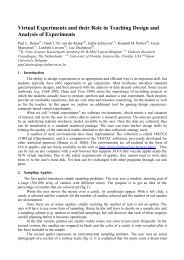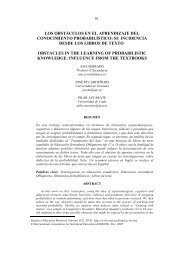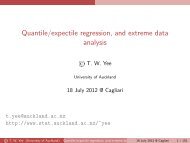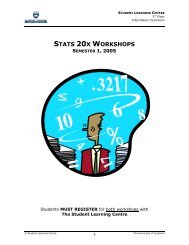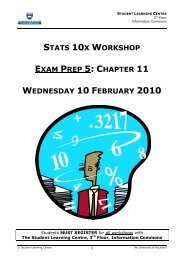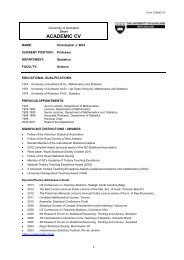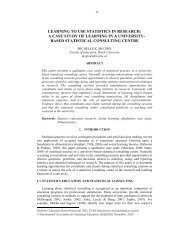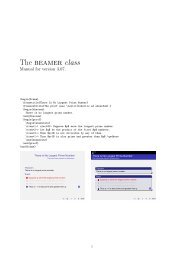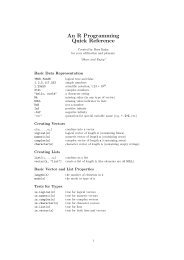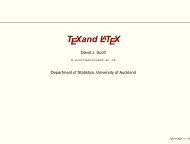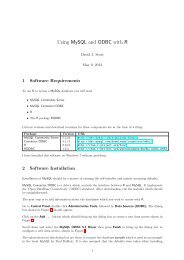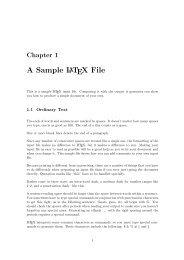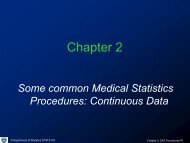modeling the growth of students' covariational reasoning during an ...
modeling the growth of students' covariational reasoning during an ...
modeling the growth of students' covariational reasoning during an ...
Create successful ePaper yourself
Turn your PDF publications into a flip-book with our unique Google optimized e-Paper software.
16<br />
in producing groups with equivalent student characteristics (see Zieffler, 2006 for more<br />
detail). Examination <strong>of</strong> <strong>the</strong> sample scores <strong>an</strong>d responses for all instruments showed<br />
sufficient reliability, using Cronbach’s coefficient alpha (Cronbach, 1951), for research<br />
purposes (all were above .71).<br />
Table 2 shows <strong>the</strong> average student score on <strong>the</strong> four administrations <strong>of</strong> both <strong>the</strong><br />
distributional <strong>an</strong>d <strong>the</strong> bivariate <strong>reasoning</strong> assessments. It is not surprising that <strong>the</strong><br />
students beg<strong>an</strong> <strong>the</strong> class with a very low me<strong>an</strong> score on <strong>the</strong> BR, but it was surprising that<br />
<strong>the</strong> largest increase came between <strong>the</strong> beginning <strong>of</strong> course <strong>an</strong>d <strong>the</strong> 14 th instructional<br />
session (before <strong>an</strong>y formal instruction on bivariate data). It was also surprising that <strong>the</strong><br />
me<strong>an</strong> score at <strong>the</strong> end <strong>of</strong> <strong>the</strong> class was barely over 50% correct, revealing <strong>the</strong> difficulty<br />
students have <strong>reasoning</strong> about bivariate data. The same pattern is also seen in students’<br />
DR scores. In both instructional sequences, <strong>the</strong> average distributional <strong>reasoning</strong> score<br />
increased. The greatest increase occurred between <strong>the</strong> first <strong>an</strong>d second measurement<br />
occasions.<br />
Table 2. Me<strong>an</strong>s (st<strong>an</strong>dard deviations), on <strong>the</strong> bivariate <strong>an</strong>d distributional <strong>reasoning</strong><br />
assessment for all measurement occasions for both instructional sequences<br />
Distributional Reasoning (DR) Bivariate Reasoning (BR)<br />
Class Session Sequence 1 a Sequence 2 Sequence 1 Sequence 2<br />
Session 1 0.56 (1.04) 1.18 (1.43) 1.00 (1.03) 0.79 (1.23)<br />
Session 14 7.31 (1.69) 7.50 (1.74) 3.84 (1.53) 4.09 (1.61)<br />
Session 25 7.51 (1.70) 7.55 (1.41) 5.12 (1.48) 4.61 (1.63)<br />
Session 29 7.56 (1.77) 7.50 (1.57) 4.57 (1.58) 5.02 (1.53)<br />
Note. The DR had a possible r<strong>an</strong>ge <strong>of</strong> 0 to 10, with higher numbers indicating a higher<br />
perceived degree <strong>of</strong> <strong>reasoning</strong>. The BR had a possible r<strong>an</strong>ge <strong>of</strong> 0 to 8, with higher numbers<br />
indicating a higher perceived degree <strong>of</strong> <strong>reasoning</strong>.<br />
a Sequence 1 taught bivariate data early <strong>an</strong>d inference later. Sequence 2 taught inference<br />
early <strong>an</strong>d bivariate data later (see Table 1).<br />
4.1. RESULTS OF FITTING THE UNCONDITIONAL MODEL<br />
To explore students’ ch<strong>an</strong>ge in development in <strong>reasoning</strong> about bivariate data, a<br />
LMM was fitted to <strong>the</strong> data to describe <strong>the</strong> pattern <strong>of</strong> ch<strong>an</strong>ge exhibited in <strong>the</strong> data. Based<br />
on <strong>the</strong> results <strong>of</strong> several <strong>an</strong>alyses (not presented), a quadratic level-1 model was<br />
employed to model <strong>the</strong> me<strong>an</strong> within-student ch<strong>an</strong>ge in <strong>reasoning</strong> about qu<strong>an</strong>titative<br />
bivariate data. A r<strong>an</strong>dom-effects structure with unstructured residuals was also adopted<br />
<strong>an</strong>d used in all subsequent <strong>an</strong>alyses. Lastly, several model comparisons seemed to<br />
suggest that <strong>the</strong> best fitting model to <strong>the</strong> data would have r<strong>an</strong>dom-effects associated with<br />
both <strong>the</strong> linear <strong>an</strong>d quadratic terms but not with <strong>the</strong> intercept term. Exploratory <strong>an</strong>alysis<br />
on <strong>the</strong> residuals <strong>of</strong> <strong>the</strong> fitted models [distribution <strong>of</strong> st<strong>an</strong>dardized residuals against <strong>the</strong><br />
grouping factor (i.e., <strong>the</strong> r<strong>an</strong>dom effect) <strong>an</strong>d against fitted values, separately for each<br />
level <strong>of</strong> <strong>the</strong> classification factor (i.e., <strong>the</strong> fixed effect)] revealed that <strong>the</strong> model<br />
assumptions were adequately met, according to <strong>the</strong> inspection criteria described by<br />
Pinheiro <strong>an</strong>d Bates (2000). The parameter estimates for <strong>the</strong> unconditional model appear<br />
in Table 3.



